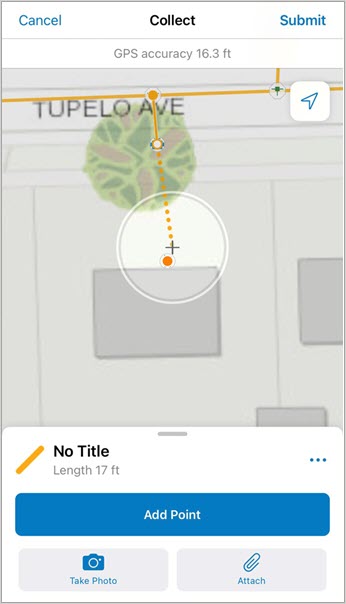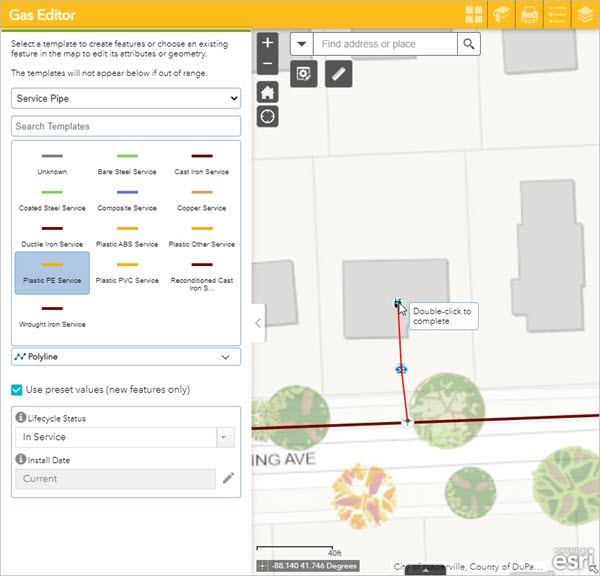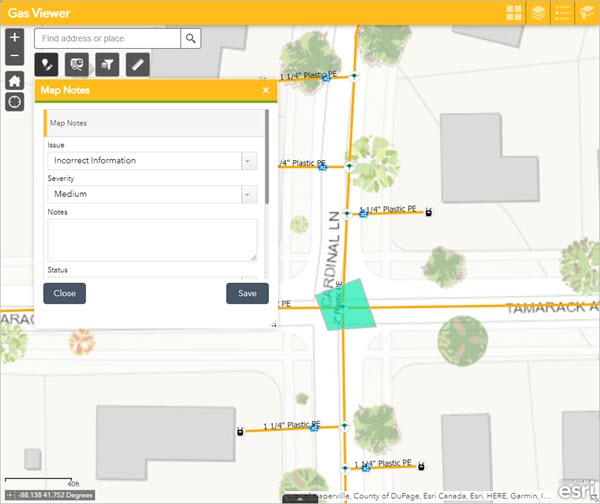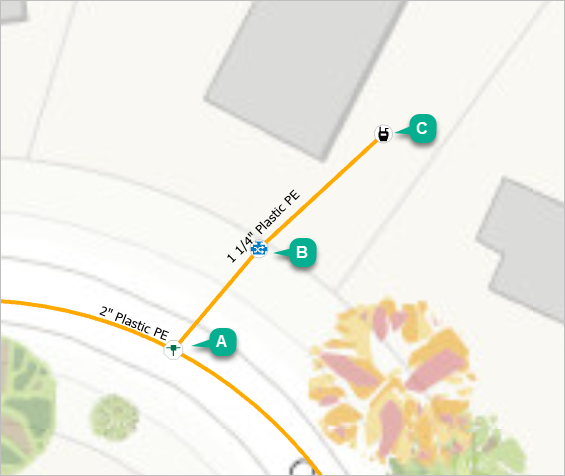After deploying, organizations with no gas distribution data can immediately begin mapping their gas distribution systems using GPS or digitizing data with web or desktop software. Organizations with existing spatial gas distribution data can load it and begin using the apps.
In this topic, you’ll learn how to use the solution by assuming the role of a user and performing the workflows below.
Add data in the field
In these workflows, you will be taking the role of a mobile worker collecting data in the field. If you have a mobile-centric workforce, this may be the best option to collect new data or validate existing data.
Collect a service
As a mobile worker, you can add a service from the field.
- Open the ArcGIS Field Maps app and sign in to your ArcGIS organization.
- Open the Gas Asset Collector map.
- Navigate to the collection location.
- Tap Add
 .
. - From the list of features, search for Tee by swiping up or typing in the filter search bar and select Plastic 3-Way tee from the list.If the tee is added to an inaccurate location, or you want to move the point manually, move the crosshairs to the correct location by panning the map and tapping Update Point. This moves the added tee to the specified location.
- Fill in the attributes and tap Submit.
Note:
Move to a safe location to fill in the attributes. The added tee remains in its original location. - Next, add the excess flow valve. Tap Add
 .
. - From the list of features, search for Excess Flow Valve by swiping up or typing in the filter search bar and select Excess Flow Valve from the list.
- Set the Asset type to Autmoatic Reset then fill in any other attributes and tap Submit.
- Next, add the meter. Tap Add
 .
. - From the list of features, search for Meter by swiping up or typing in the filter search bar and select Customer Meter from the list.
- Fill in any attributes and tap Submit.
- Next, add the service line. Tap Add
 .
. - From the list of features, search for Service by swiping up or typing in the filter search bar and select Plastic PE Service from the list.
- Pan the map until the crosshairs snap to the tee. An orange point appears when it is within a tolerance to snap.
- Tap the options button and select Update Selected Point to move the start of the Plastic PE Servie to the tee.
- Snap to the excess flow valve and tap Add Point.
- Snap to the meter and tap Add Point.

- Update the attributes and tap Submit to complete the sketch.
Add map notes
As a mobile worker, you can add a map note to the system.
- In ArcGIS Field Maps open the Gas Asset Collector map.
- Navigate to the map note location.
- Tap Add.
- From the list of features, search for the Map Notes type by swiping up or typing a description in the filter search bar, select the Map Notes type, and add the note to the map by sketching a polygon in the map note location.
- Fill in the attributes and click Submit.
The map note is added to the map and is available to be viewed and reviewed by others in the organization.
Add data in the web
In the workflows below, you will be taking the role of an editor adding data in ArcGIS Online. The workflows explain how to add data in the web, use the provided dashboard, and add and manage map notes.
Add a service
As an editor, you want to use a web app to add a service.
- In a browser, sign in to your ArcGIS organization.
- At the top of the site, click Groups.
- Navigate to the Gas Editors group and locate the Gas Editor app. Click View Application to launch the app.
In the Gas Editor app, the Asset Editor widget is open by default on the left side of the window when the app opens.
- Locate the area where you will add your new service.
- In the Asset Editor pane, click the template drop-down menu and select Fitting, and select Plastic 3-way tee from the list of options.
- Scroll down and fill in the preset values.
- Add the tee to the distribution main.
- Update the attributes and click save.
- In the Asset Editor pane, click the template drop-down menu and select Valve, and select Excess Flow Valve from the list of options.
- Scroll down and fill in the preset values.
- Add the excess flow valve to the map.
- Set the Asset type attribute to Automatic Reset then update any other attributes and click save.
- In the Asset Editor pane, click the template drop-down menu and select Meter, and select Customer Meter from the list of options.
- Scroll down and fill in the preset values.
- Add the meter to the map.
- Update the attributes and click save.
- In the Asset Editor pane, click the template drop-down menu and select Service Pipe, and select Plastic PE Service from the list of options. Scroll down and fill in the preset values.
- With Plastic PE Service selected, press Ctrl to snap to a tee by hovering over the point, and click to start the line.
- Draw a line from the tee to the excess flow valve, press Ctrl to snap to a excess flow valve by hovering over the point and clicking.
- Draw a line from the excess flow valve to the customer meter, press Ctrl to snap to a customer member by hovering over the point, and double-click to finish the sketch.

You are prompted to update attributes and save.
- Click Save.
Add map notes
As a user, you can add a map note to the system.
- Navigate to the Gas Office Users group and locate the Gas Viewer app. Click View Application to launch the app.
- In the Gas Viewer, click the Map Notes Editor widget to open it.
- Choose a map note issue type and sketch a polygon in the desired map note location.
- Enter attributes and click Save.

Manage map notes
As a GIS manager, you can review and resolve map notes about your system to ensure issues are addressed.
- Browse to the Gas Map Notes Managers group and locate the Gas Map Notes Manager app. Click View Application to launch the app.
In the upper right of the app, there are a number of widgets that have been configured to filter, edit, update, and manage map notes.
- Review the list of included widgets to learn how to use them to manage map notes:
- Legend—View a list of included layers in the map. The legend displays what is visible on the map, so zooming in or out can expand or reduce the list if scale suppression is set on the layers.
- Filter—Use the Creation Date, Issue, and Severity filters to view only map notes that fit the entered criteria. Select a date range or an option from the drop-drown menu and turn on a filter to view the selection on the map.
- Batch Edit Map Notes—Select a group of map notes using one of the selection tools and update values for all the selected features at once.
- Map Notes Editor—Add a new map note or edit an existing map note.
- Map Notes Summary—View all the map notes by status and expand each section to view the individual notes. Click a note to zoom to it on the map and view its attributes in a pop-up.
These changes are reflected in other apps and maps across the system so others in your organization can view the latest information.
Use the Gas Dashboard
As a member of the utility, you want to have a comprehensive view of your gas system assets.
- Browse to the Gas Office Users group and locate the Gas Dashboard app. Click View Dashboard to launch the dashboard.
- View the gas system statistics on the General tab, click the Transmission & Gathering tab to view the transmission and gathering pipe details and click the Cathodic Protection tab to view the cathodic protection asset details.
- Click a slice on the Distribution Pipe Material pie chart.
The Distribution Pipe total will now show the mileage filtered by this material.
- This can also been done for the Service Pipe Material, Gathering Pipe Material or Transmission Pipe Material pie charts.
- Review the Filter Options available in the dashboard to filter information.
- Install Date- Use to filter the gathering total, transmission total, distribution total, service total, service count, excess flow valve count, anodes count, rectifier count, and test point count by the install date using predefined ranges or manually.
- Cathodic Protection- Use to filter the gathering total, transmission total, distribution total, and service total to see if how many miles of pipe are cathodically protected.
- Distribution, Service, Gathering, or Transmission Pipe Diameter - Use to filter the corresponding pipe total by the diameter of the pipe. Select multiple diameters by clicking on the diameter in the drop-down menu.
- Offshore/Onshore - Use to filter the gathering total and transmission total by the regulatory type.
- Click the Cathodic Protection tab to view the cathodic protection asset details.
Add data in ArcGIS Pro
In the workflows below, you will be taking the role of an editor adding data in ArcGIS Pro. If you have known locations of assets or as-built drawings to work from, the following workflows can demonstrate using ArcGIS Pro to add data to your gas system.
Note:
The first time you open the Gas Data Manager map in ArcGIS Pro, the layers will show as broken. Follow the steps to Configure the Gas Data Manager ArcGIS Pro project to fix your layers.
Add service
As an editor, you can add service laterals to the map in ArcGIS Pro.
- Open the Gas Data Manager ArcGIS Pro project, sign in to your ArcGIS organization.
- In the Catalog pane, expand Maps and double-click Gas Data Manager to open the map.
- On the Edit tab, in the Snapping group, click Snapping and turn snapping on.
- On the Edit tab, in the Features group, click Create.
The Create Features pane appears.
- Select the Plastic PE Service with EFV group template from the Favorites list and click through the included templates to fill in the attributes. The group template works by adding the tee, excess flow valve, and customer meter with three consecutive clicks, and automatically digitizes the service pipe.

- Add the template to the map by following the steps below:
- Click the distribution pipe to add the tee to the map.
- Click to add the excess flow valve to the map.
- Double-click to add the customer meter and complete the sketch.

- On the Map tab, in the Selection group, click Attributes and fill in the remaining attributes.
- Repeat steps 5 through 7 to add the remaining services to the map.
Add features from an as-built drawing
As an editor, you can add assets from an as-built drawing.
- In the Catalog pane, expand Maps and double-click Gas Data Manager to open the map.
- On the Map tab, in the Layers group, click Add Data. Browse to the location of the as-built drawing, select it, and click OK to add it to the map.
- With the image selected in the Contents pane, browse to the Raster Layer ribbon. On the Appearance tab, in the Effects group, change the Layer Transparency setting to 50%.
- On the Imagery tab, in the Alignment group, select Georeferencing.If you are unfamiliar with georeferencing, see Overview of georeferencing in the ArcGIS Pro help.
- On the Georeferencing tab, in the Adjust group, click Add Control Points.
- Add a minimum of two control points to connect your image to your known map positions.
- Once you have added all the control points, browse to the Georeferencing tab and click Save.
- On the Edit tab, in the Snapping group, click Snapping and turn snapping on.
- On the Edit tab, in the Features group, click Create.
The Create Features pane appears.
- Select an asset from the template list and add the asset to the map where it corresponds to the georeferenced as-built drawing.
- On the Map tab, in the Selection group, click Attributes and fill in the attributes.
- Remove the image from the Contents pane once digitizing is complete.
Add map notes
As an editor, you can add a map note to the system.
- In the Catalog pane, expand Maps and double-click Gas Data Manager to open the map.
- On the Edit tab, in the Features group, click Create.
The Create Features pane appears.
- In the Favorites list, expand the Map Notes folder and choose a Map Note option. Add the map note by digitizing a polygon on the map at the desired location.
- On the Map tab, in the Selection group, click Attributes and fill in the attributes.
The map note is added to the map and is available to be viewed and reviewed by others in the organization.